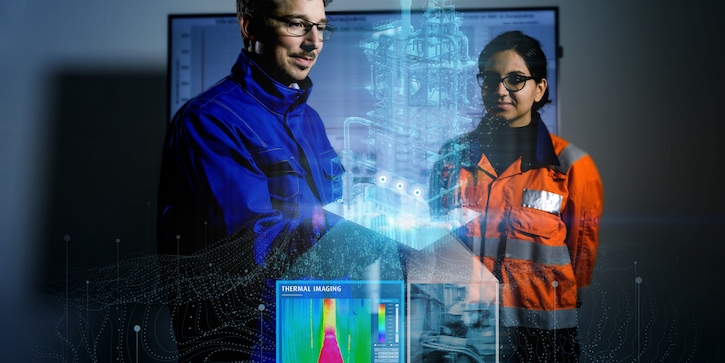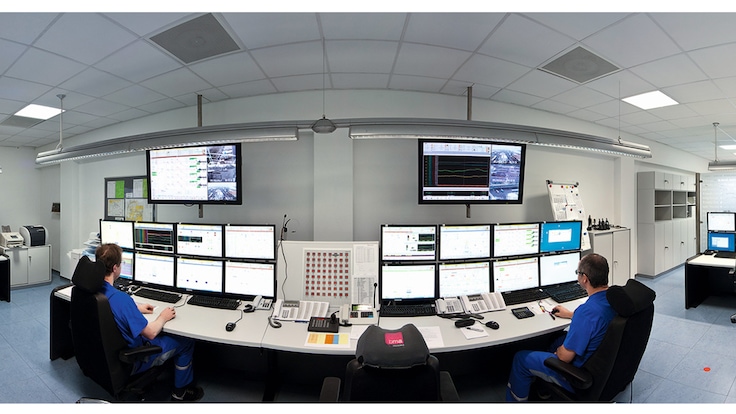
Optimizing furnace operational efficiency in real-time
How real-world plants are learning from their digital twins.

Data plays a vital role in maximizing plant availability - whether it be used for remote diagnostics, predictive maintenance or digital twin modeling. Linde Advanced Operations Services has set itself the task of collecting and processing data as effectively as possible so it can be transformed into real business value. This data-enabled consulting service provides customers with a host of benefits.
Being able to predict what’s going to happen in 60 days may sound like science fiction, but that’s exactly what a modern industrial plant can do. This kind of forecasting calls for a digital twin. These virtual replicas model real-world plants to support a whole range of features and functions. “We can use a digital twin to fast-forward operating processes and thus take a glimpse into the future,” explains Thomas Heinzerling, Senior Vice President of Linde Advanced Operations Services. “These insights are gained by combining a blueprint of the real-world plant with massive streams of operational data and smart algorithms that make sense of all this information.” New data is fed into the digital twin every fifteen minutes. This information is then used to calculate what is going to happen in the plant over the next two months or so. The virtual twin runs faster than its real-life counterpart, allowing operators to plan more effectively and schedule, for example, the optimum window to take a furnace offline for maintenance or cleaning work such as decoking. They can see if a real-world plant is starting to deviate from the optimum operating parameters and can instantly respond with corrective measures geared towards maximizing plant availability.
“We can use a digital twin to fast-forward operating processes and thus take a glimpse into the future.”

Until now, Linde has used digital twins mainly to support the plant engineering process. “Now, we’ve tuned the model to simulate live operations, so the simulation can be continuously compared to real-world operations to uncover optimization potential,” adds Christoph Heckmann, Senior Business Development Manager at Linde Advanced Operations Services. The team is also developing a digital twin for key plant components. Linde Virtual Furnace is a prime example of this. “For petrochemical customers, the furnace is the absolute heart of an ethylene cracker, generating significant value every day,” confirms Heinzerling. The entire operational process flow can be simulated using real-time temperature measurements captured by infrared cameras coupled with information on other key parameters such as the feedstock and product streams. This simulation then supports important forecasts for the real furnace such as the speed at which coke is forming or the remaining efficient runtime under current conditions. This is extremely valuable information that can contribute to the profitability of the furnace and the entire plant.
But Heinzerling and his team do a lot more than just predict the future. “We offer general consulting services based on real-time data from entire plants or their individual components, mainly evaluating parameters such as pressure, temperature and vibrations,” elaborates the Linde expert. “The process control system also provides valuable data”. In some cases, however, additional sensors have to be integrated to ensure product quality, for example. These continuous streams of data are then processed by intelligent algorithms and evaluated by Linde experts. If a problem arises, they can contact the customer and work with them to develop a solution. In some instances, the team calls on their colleagues from LINDE PLANTSERV®, who support with spare parts deliveries and their in-depth repair know-how. What’s more, the data-enabled services provided by experts at Linde Advanced Operations Services can be quickly and easily implemented without any big upfront capital expenditure. These services also pay for themselves in a short space of time. “Our aim is to boost the overall availability of plants by bringing new levels of transparency to operations. This increases overall profitability and efficiency – which is naturally the overarching goal that both we and our customers want to achieve,” explains Heckmann.
“Our aim is to boost the overall availability of plants by bringing new levels of transparency to operations. This increases overall profitability and efficiency – which is naturally the overarching goal that both we and our customers want to achieve.”

All of this data supports another valuable use case: remote diagnostics. The team at Linde Advanced Operations Services looks at these data streams to identify plant processes that are not or are no longer running within the optimum window so that early corrective action can be taken. In a nutshell, remote diagnostics involves getting as accurate a picture as possible of general plant health. “We build on assets such as Linde’s Remote Operations Centers, renting out capacity there for our plant customers. The people who work at the ROCs have a wealth of operational experience, which is a major benefit,” explains Heinzerling. “Once the self-learning algorithms have filtered the data, it is sent to the center’s employees, giving them the information they need to assess the health of a plant”. To be able to do this, however, the algorithms must first be trained. Which is where the vast experience that Linde Gas has gathered over the years comes into play. Over 1,000 plants, many with more than ten years’ worth of operational data, provide valuable training material. The bigger the data set, the more effective the algorithm and thus the more accurate the assessment of plant health and ability to identify components that may already have reached their limit. Altogether, Linde’s plants collect more than 650,000 data points every minute, providing a rich source of input for algorithms and a means of validating them.

“We’re not just good at building algorithms. We also have a huge wealth of operational know-how – which translates into actionable insights for our customers,” says Heckmann. His team is an interdisciplinary taskforce that combines many years of experience in plant and component engineering with operational expertise – while always looking towards the data. “Our customers might contact us in order to reduce their maintenance costs by 30 percent, for example. They could be looking to improve throughout in their plants or increase efficiency levels,” continues Heckmann. “That’s the kick-off point for us and we start to develop our data-based solutions on that basis. We generally try to use off-the-shelf modules to create a tailor-made suit.” Once a solution has been found and presented to the customer, the team usually follows up with a visit to a reference installation such as one of Linde’s own plants. “Customers have to see a lot of what we do for themselves - in the real world. It makes us more credible and builds trust. We know from experience that a presentation on paper simply doesn’t have the same impact,” explains Heinzerling. On the ground, customers can clearly see that the Advanced Operations experts are excellent at what they do.
“Alongside its focus on digital technology and data-driven services, the Advanced Operations team also maintains regional networks with different partner companies to ensure a rapid local response in the event of a problem. Alongside its focus on digital technology and data-driven services, the Advanced Operations team also maintains regional networks with different partner companies to ensure a rapid local response in the event of a problem.”
Plant operators also benefit from Linde’s expertise in data and IT security. After all, the company also operates its own data network spanning 1,000 plants in 100 countries - and the majority of these are operated remotely. “Just like our customers, we operate a critical infrastructure integrating various facilities, and have to protect ourselves from hackers and viruses. So, we can provide them with extremely useful information,” says Heckmann. Alongside its focus on digital technology and data-driven services, the Advanced Operations team also maintains regional networks with different partner companies to ensure a rapid local response in the event of a problem. To ensure it stays ahead of the curve, Linde has to accurately identify the challenges of tomorrow and make sure it is on the right track to tackle these issues. It has certainly built a strong foundation to do just that with Linde Advanced Operations Services.